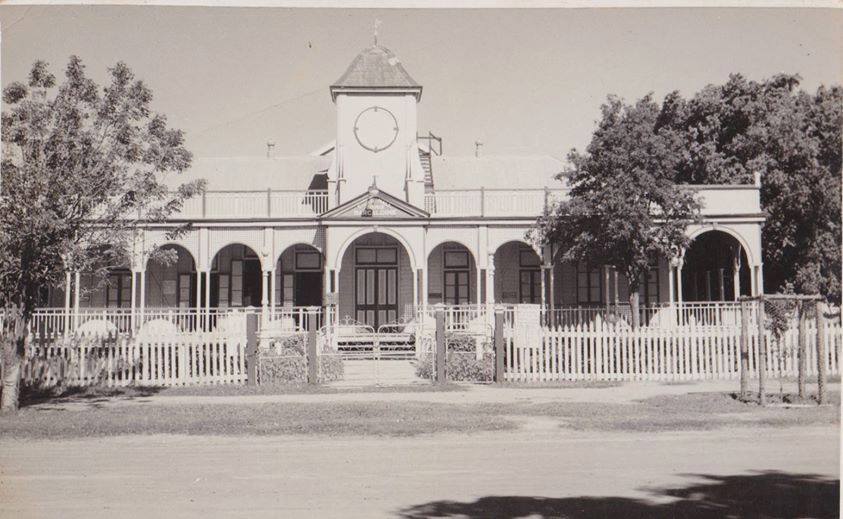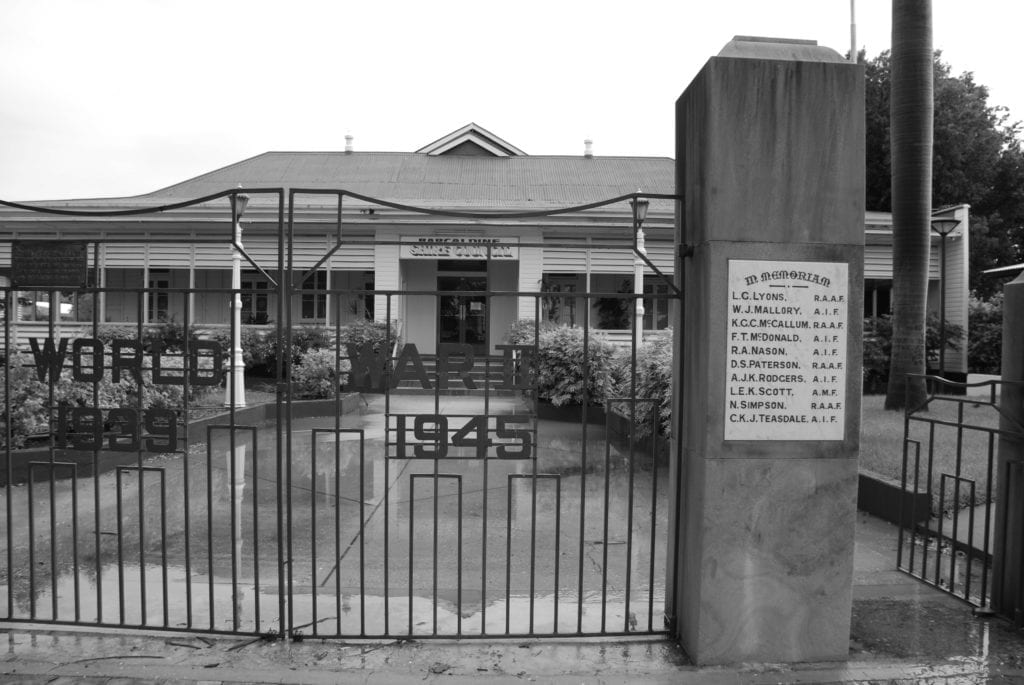Barcaldine War Memorial Clock
The clock is a heritage-listed memorial at the intersection of Ash Street and Beech streets, Barcaldine. It was designed and built in 1924 by monumental masons Andrew Lang Petrie and Son, monumental masons of Toowong, Brisbane at a cost of £524. A major regional memorial, the clock was unveiled on 21 May 1924 by the-then Governor of Queensland, Sir Matthew Nathan. It was added to the Queensland Heritage Register on 21 October 1992.
The marble and granite memorial honours the 292 local men who served during the First World War, including the 38 fallen.
Australia, and Queensland in particular, had few civic monuments before the First World War. Although many different types of war memorials were erected throughout Queensland, there are few of the clock type. The form of a clock was decided upon by public ballot held in 1922 after the Barcaldine Shire Council initiated the proposal for a memorial.
Unveiling of Soldiers' Memorial
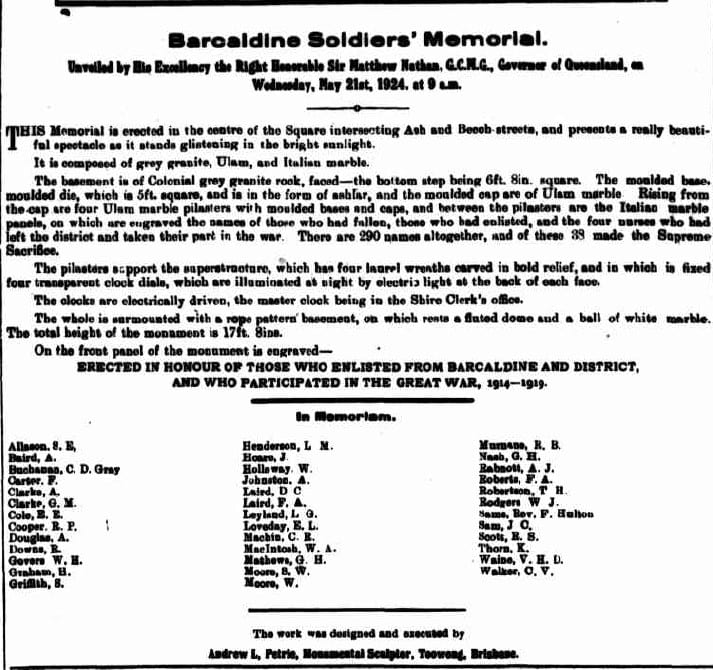
It was a happy thought on the part of the Chairman of the Barcaldine Shire Council to invite his Excellency Sir Matthew Nathan, Governor of
Queensland, who was returning from an extensive tour of the far-western and northern portions of the state, to break his journey when passing through Barcaldine and unveil the recently-erected soldiers’ memorial, and it was extremely gratifying to the Shire Council and the Ladies’ Committee, who had done so much to raise funds to erect the memorial, that his Excellency graciously accepted the invitation and agreed to perform the unveiling ceremony. The Governor’s special car was attached to the down goods train on Wednesday morning last, May 21st, and this arrived punctually at 9 a.m. Prior to this, flags and hunting had been displayed in and around the vicinity of the memorial, while the monument itself was draped with a Union Jack and Australian flag. The school children-from the State, Convent, and St. Peter’s schools-had been marshalled, forming a line leading to a dais, which had been erected in front of the monument. The children, who numbered some hundreds, sang the National Anthem (being accompanied by some members of the Orchestra) as the Governor and party arrived, and their voices blended sweetly in the fresh morning air.
There was a very large attendance of citizens. His Excellency, who was accompanied by Captain Turner, A. D.C., was met and welcomed at the railway station by Mr. E. F. Lyons, Chairman of the Shire Council, Crs. R. A. Parnell, J. J. Fawkes, Mr. C. H. Fysh (Shire Clerk), and other prominent townsmen. The party then motored in Mr. F. E. Hall’s fine new Buick car to the monument. After the singing of the National Anthem, Mr. Lyons Introduced His Excellency to members of The Ladies Committee, the heads of the schools, school teachers, and other townsmen present, and Misses Eileen and Gwen Lyons, on behalf of the ratepayers, presented the Governor with a beautiful bouquet of roses, regarding which his Excellency expressed much admiration. He thanked the young ladies very much for their gift. The roses came from the garden of Mrs. P. McCabe, North Side, and no doubt It was a beautiful bunch of vari-colored blooms.
His Excellency, Messrs. R. F. Lyons, and R. A. Parnell And Mesdames W. T. McKie and R. F. Lyons then took their seats on the dais.
Mr. Lyons said they were assembled there that morning to do honor to his Majesty the King through his representative, Sir Matthew Nathan, P.C., G.C.M.G., Governor of Queensland, also to thank his Excellency personally for visiting them that day, and to assist him with the unveiling of the memorial erected by the residents of Barcaldine and district in memory of the brave soldiers and loving nurses who enlisted for service in the great war from this district. Before proceeding, he would like, very briefly, to give the history of the memorial up to date. The movement was started by the Shire Council In 1921. The Council opened a subscription list with the object of raising £1000 by voluntary contributions. Over £200 was raised in this way but this was thought rather slow, and the ladies in 1922 took the matter in hand, and by their energy, enthusiasm, and resourcefulness. In a few months had raised a further sum of over £800. The President of the Ladies Committee was Mrs. W. T. McKie, and the hon. secretaries from time to time were Mesdames J. A. H. Fraser, W. James, W. T. Colman, and Miss Fysh. He mentioned those names as they were the head of the movement, but all the ladies worked very hard- to achieve their object, and it was the crowning feature of their efforts to have his Excellency there that day to unveil the memorial. In all, £1113 had been raised, which was augmented by a small amount from the bank for interest, bringing the total up to £1120.
A public meeting was then called and Plans and estimates were considered, and this design and site was chosen. Then the contract was let
and in due course the memorial was erected. It cost £1028. Then they had to install the electric light inside the clock at a cost of £20 and now they intended expending a further £60 in erecting four corner posts to protect the monument from the traffic. The total cost, therefore, would be £1108, and there was £12 in hand. They were also having inscribed on the base: “Erected by the residents of Barcaldine and district, and unveiled by his Excellency the Right Honorable Sir Matthew Nathan, G.C.M.O., Governor of Queensland, 21st May, 1924”. That brief history brought them right up to date.
His Excellency was just completing a long, arduous tour of the outlying parts of Queensland. They had heard of people “doing the block” In the cities, but his Excellency had been “doing the back blocks.” They would appreciate that when he stated that the telegram his Excellency had sent him, here through Mr Aide-de-Camp graciously accepting their invitation to be here that day was sent from Urandangie, which was a few miles from the South Australian border. His Excellency had also visited Mount Isa, and in a few weeks he had trodden where no other Governor, or at any rate any Governor wearing shoe leather, had trodden before. No doubt the people in those outlying districts were as pleased to see his Excellency as they were to see him there that day. He would then respectfully invite Sir Matthew Nathan to perform the unveiling ceremony of their Soldiers’ Memorial. (Applause.)
His Excellency Sir Matthew Nathan, who rose amidst applause, said it was nine years since Australia made her great entry into the great war-since the Queensland and other battalions of the A.I.P. gained a foothold on the craggy shores of Gallipoli, and Australia laid claim to nationhood. It was five years since at the conclusion of a life and death struggle that the A.I.F. had done so much to make victorious this claim received full and formal recognition. In the interval Australians had suffered and died- suffered to the full extent of human endurance and beyond it, died in circumstances of utmost awfulness.

And now! As a result of those sufferings and the deaths they stood there that day with the ancient freedom of Britons still theirs- with the new nationhood of Australia free to develop on lines that may put all ancient civilisation in the shade. For that freedom and those possibilities they stood indebted to the men whom that monument had been erected and to their lives. They owed to those of them that had lost their lives a recollection that should never fade and the constant care of those they left behind them. They owed to them who had come back an appreciation that they were the best in the land picked out by their own courage and public spirit, and deserving of the deepest gratitude of the country they had kept so splendidly free. They owed to all the men of the great war-alike the living and the dead-that they should do all in their power to make the land for which they suffered and died a Country of high ideals and the nation that they created one in which peace shall have still greater victories than war, conquering the powers of evil, destroying enmities, and bringing through righteousness happiness to all the People. (Applause.)His Excellency then unveiled the memorial, reading aloud the names – 38 – of those who had made the Supreme Sacrifice. The Governor then said that that concluded the little ceremony. Addressing the children he said he wanted them to remember that day, and when they grew up be prepared, like the men whose names were on the monument, to do all they could for their country. They would probably not have the opportunity – he certainly hoped they would not have the opportunity – of serving it in the field fighting for it, although should the need for that arise he felt sure the men of the future would be as good as the men of the past. He hoped such a need would not arise, but nevertheless they would have plenty of scope for their energies in making their country what Nature intended it to be – one of the finest countries in the world. He wanted them to remember that occasion, and it would impress itself more on their mind if they had a day to think about it than other wise. Next Tuesday week was a holiday, so he would grant them a holiday on Monday. (Loud applause from the children).
Upon the call of Mr. Lyons, three cheers were then given for his Excellency by the children, who subsequently again sang the National Anthem. The Governor then moved among the people for a while, after which at his own request he was driven, to the Convent to meet Sister Scholastica, Mother Superior of the Convent. A visit to the Hospital was then made. His Excellency was escorted through the several wards by Dr. J. Cook and Matron Green, the Governor having a cheery word for the patients as he passed along. The new Maternity Hospital was inspected, and this fine up-to-date, building was favorably commented upon. Before leaving the hospital, his Excellency signed the Visitors’ Book, adding the brief comment “And Still’.,” referring to his previous remarks (on two occasions) that a new operating theatre was badly needed. In 1921 his Excellency wrote in the Visitors’ Book: “A very good hospital, but a new operating theatre is badly required.” In 1923 his Excellency wrote: “My remarks of two years ago still apply.” And now on the present occasion he has written “And still!” Mr- Lyons explained to his Excellency the present financial position of the hospital, adding that the funds would not stand the erection of a new theatre at the present moment. Mr. Lyons also mentioned to the Governor about the Government withholding the Golden Casket grant from the hospital, and stated the institution was really now carrying on on its capital. His Excellency appeared very interested in hospital matters and asked the secretary to supply him with copies of the annual report and balance sheets. He inquired of the Matron what sort of quarters the nurses had. “They are not bad, your Excellency,” said the Matron, “but we are hoping for better.” “I think you live a lot on hope out here, Matron,” remarked his Excellency. After the hospital, a visit was made to The Club, and then the Vice-Regal party were motored to the railway station, and the journey east was continued. A number of townspeople fare welled the Governor at the station.
Western Champion 24 may 1924
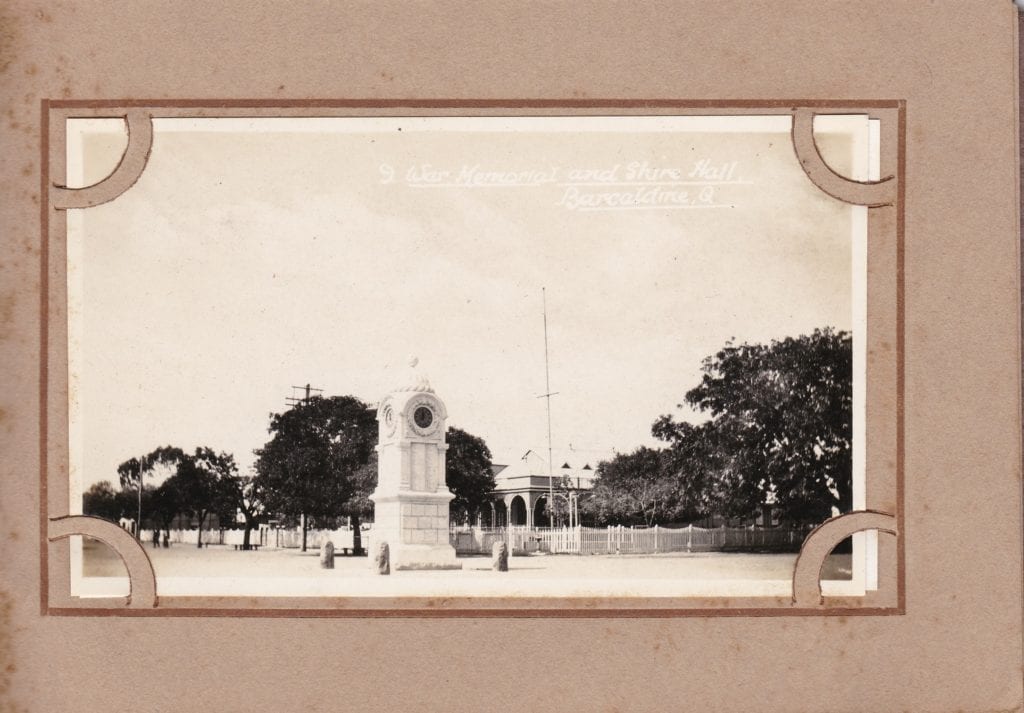
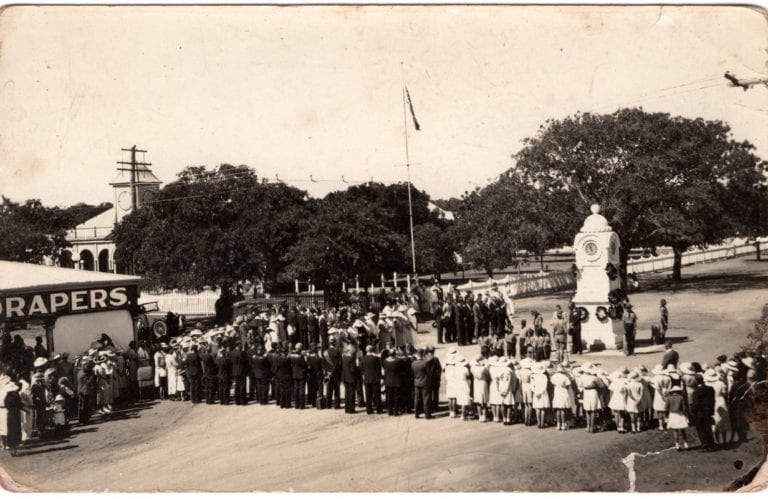

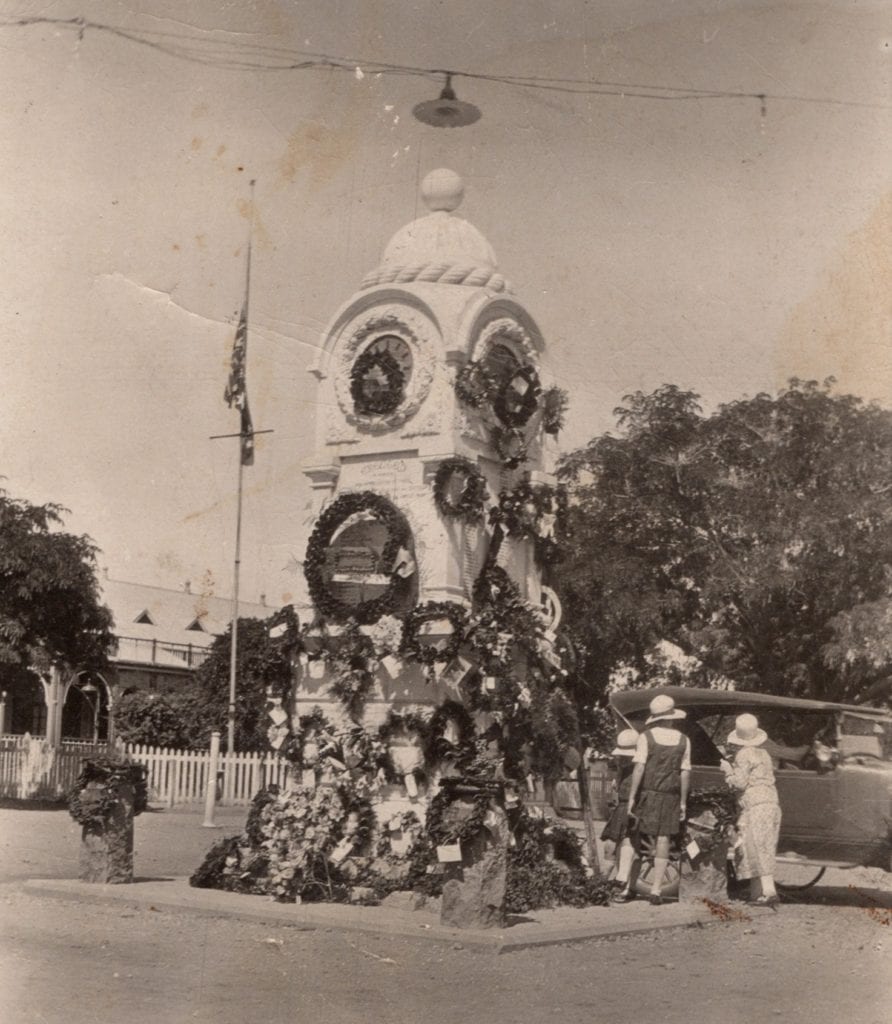
The memorial clock has been the centre of Anzac Day celebrations since its installation.
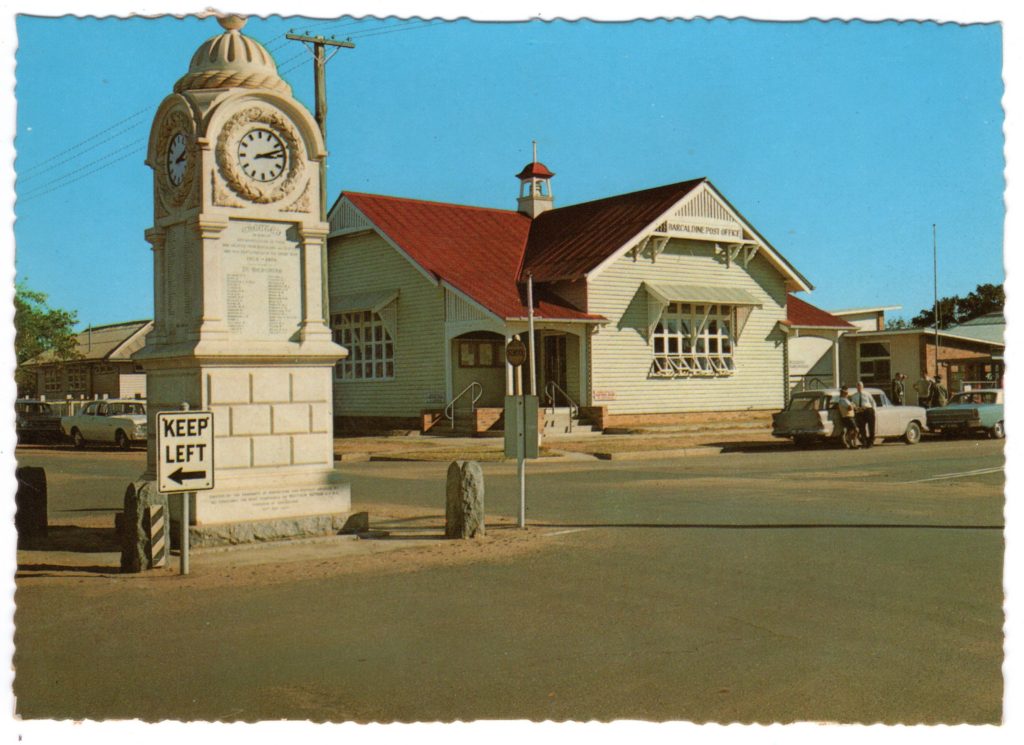
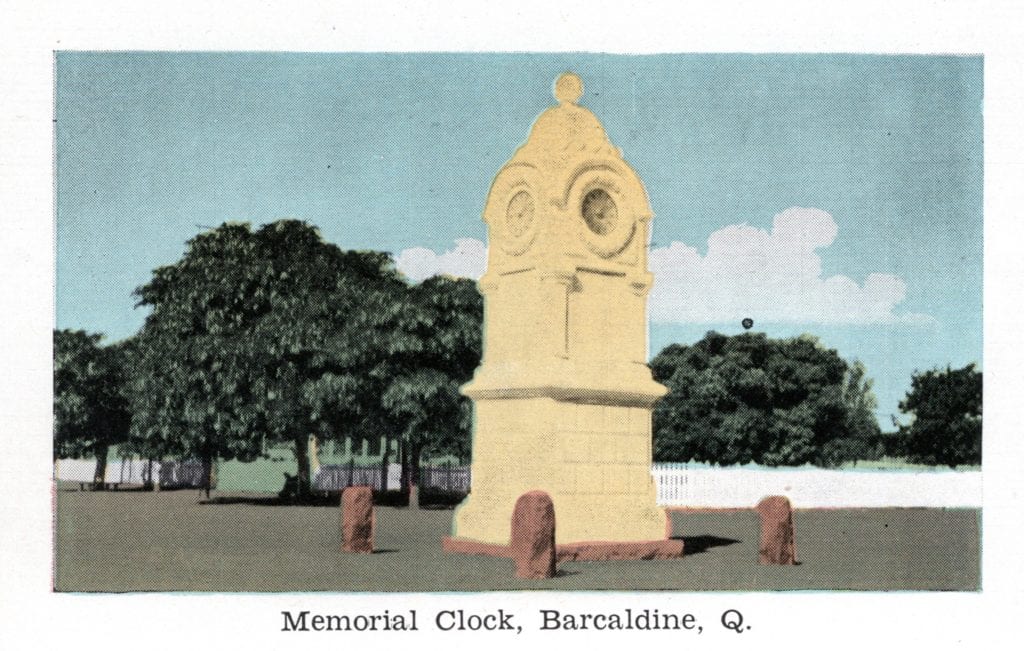
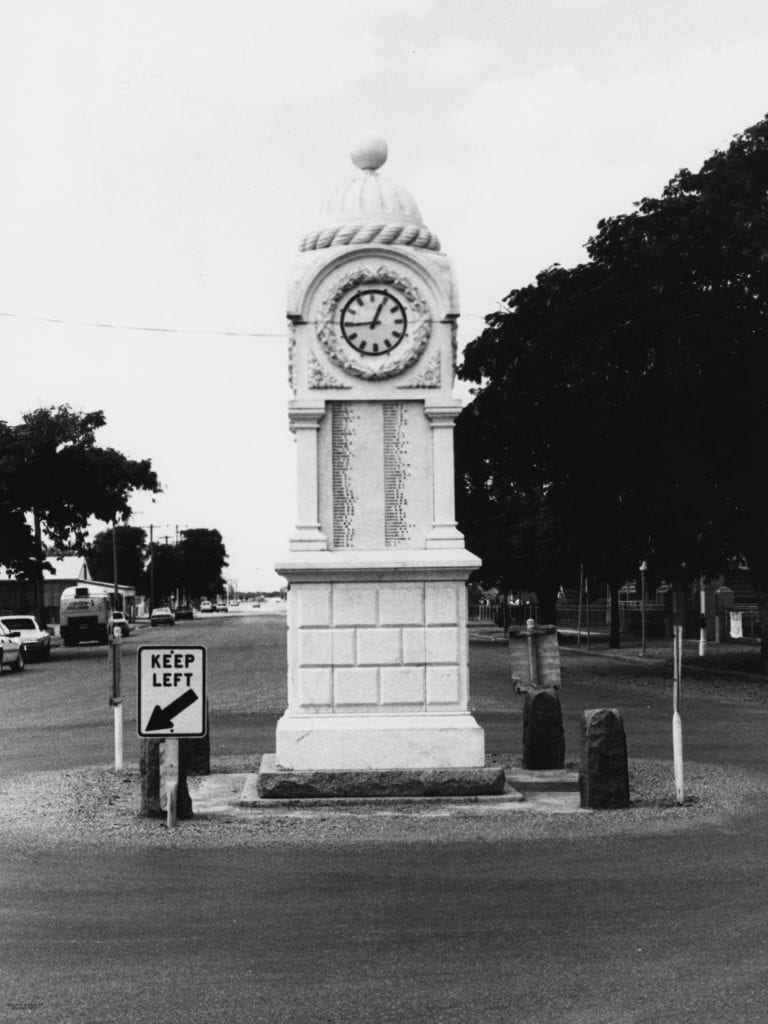
Clock structure - Description
This is a particularly ornate type of war memorial. Although no others have been located in Queensland, the design is described in A L Petrie’s records as ‘clock tower number two design’. The monument was originally surrounded by four granite posts, however these have been removed at some stage, as has the original street light. In 1992, the monument was damaged by a storm and the clocks were replaced by Synchronome Pty Ltd.
The First World War Memorial is situated in the middle of the intersection of Ash and Beech Streets, Barcaldine and is an dominant feature in the streetscape. It stands on a concrete pad with rough hewn stone posts at each corner.
The memorial stands 12 feet high and comprises a base surmounted by a pedestal and clock.
The marble (probably Ulam) memorial sits on a stepped base of rough hewn granite. Above this is a smooth faced marble step capped with cyma recta mouldings and a leaded unveiling inscription on the front face. This is surmounted by a marble plinth carved to represent chamfered blocks and capped with a simple cornice.
Rising from the plinth is the pedestal comprising recessed square plates of a finer marble with engaged pillars at each corner. The recessed plates bear the leaded names of the 292 local men who served in the first World War, including the 38 fallen whose names are recorded on the front face.
The clock sits above the pedestal. There is a clock face on all four faces which are illuminated at night. Each face is surrounded by a laurel wreath and foliated carving is located in the bottom corners. A hood mould over each face creates a domed surface on which sits a large cable moulding. This is crowned by a smaller dome surmounted by a marble sphere.
The dials of the four clock faces are driven from a master clock with an electrically-driven pendulum housed in the Barcaldine Shire Hall.
Heritage Listing 1992
The Barcaldine War Memorial Clock was listed on the Queensland Heritage Register on 21 October 1992 having satisfied the following criteria:
The place is important in demonstrating the evolution or pattern of Queensland’s history.
War Memorials are important in demonstrating the pattern of Queensland’s history as they are representative of a recurrent theme that involved most communities throughout the state. They provide evidence of an era of widespread Australian patriotism and nationalism, particularly during and following the First World War. The monuments manifest a unique documentary record and are demonstrative of popular taste in the inter-war period.
The place demonstrates rare, uncommon or endangered aspects of Queensland’s cultural heritage.
This memorial is of particular significance as it is one of the few clock type war memorials and the only one of this style in Queensland.
The place is important in demonstrating the principal characteristics of a particular class of cultural places.
Erected in 1924, the memorial at Barcaldine demonstrates the principal characteristics of a commemorative structure erected as an enduring record of a major historical event. This is achieved through the use of appropriate materials and design elements.
The place is important because of its aesthetic significance.
It is of aesthetic significance both as a dominant landmark in the streetscape and for its high level of workmanship, materials and design.
The place has a strong or special association with a particular community or cultural group for social, cultural or spiritual reasons.
The Barcaldine memorial has a strong and continuing association with the community as evidence of the impact of a major historic event and as the focal point for the remembrance of that event
The place has a special association with the life or work of a particular person, group or organisation of importance in Queensland’s history.
It also has special association with monumental masonry firm A L Petrie and Son as an example of their workmanship.
Barcaldine War Memorial Gates
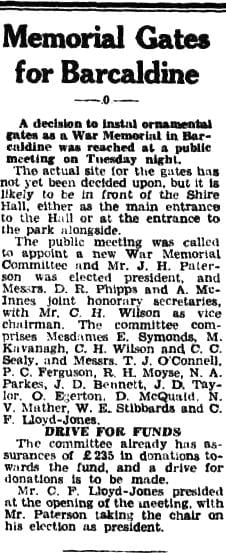
The memorial gates stand at the front of the Barcaldine Shire Hall in Ash Street. They commemorate those from the district who died in service or were killed in action during World War Two. On each side of the gates the names of the fallen are listed on marble tablets. The gates also contain the names of those who served.

